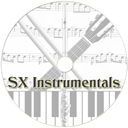Filter on ALL, SYNTH, DRUM, SAMPLER or MISC |
Total list currently 2405 items in 330 Brands |
Roland | Juno-G |
Description | Is the Juno back? Maybe. The Juno-G is a full-sized Workstation Keyboard from Roland featuring much of Roland's current state-of-the-art synthesis technologies, putting a studio's worth of sound, sequencing, and audio recording into one complete instrument. It shares the same high-powered processor as Roland's Fantom-X series but packages it in a synth that looks very reminiscent of the old Juno-synths, and also puts many of the controls at your finger tips. Not to mention, considering what you get, the Juno-G is a very affordable synth. Roland's powerful Fantom-X sound engine offers up to 128 voices of polyphony (a quantum leap from the 6 voices offered by the original Junos). The sounds of the Fantom-X engine are typical of Roland's most current sonic palette. This is no analog wannabe synth, its sounds are purely digital although many analog modeled sounds are available. You also get Roland's 88-note multi-sampled grand piano, and a wide range of sounds that span from classical to cutting-edge. You can further expand your Juno-G sound library with one of Roland's optional SRX expansion boards. True to its workstation capability, the Juno-G features an onboard audio/MIDI recorder for programming and recording your own music sequences. There is a 16-part MIDI sequencer with dedicated transport controls and mixer. There are also four companion stereo audio tracks which allow you to lay down live parts from external audio sources (like vocals, guitar parts, etc.). Both the MIDI sequencing and audio recording memory is ample, allowing room for plenty of recorded ideas, performances, songs and parts. The Juno-G has a fairly user-friendly interface featuring a very large back-lit LCD display (not a touch screen), clearly labeled buttons, six knobs to modify sounds, five sliders for the audio section, a data wheel, a D-Beam controller, and a pitch/mod lever. Additional performance controls and features include the on-board Arpeggiator, Chord Memory and built-in multi-effects. The Juno-G really has everything you need to perform, compose, record and create your music. Of course it offers MIDI in/out as well as USB connectivity for interfacing with computers (all MIDI communications can be handled over USB, which can also be used to send and receive WAV/AIF files and patch data). There's also a PC Card slot (which accepts CompactFlash or SmartMedia cards via adapter) for external memory storage. Make no mistake about it - this is not your father's Juno! In fact, this may just be a slight repackaging of the Fantom synthesizers with a retro namesake and look. If you were expecting the Juno-G to be the reanimation of Roland's most famous vintage poly-synth, you may be disappointed. However, if you are interested in Roland's cutting edge synthesis engine, sounds and features in a synth with a retro vibe, the Juno-G may be what you are looking for in an era where most equivalent workstations have a polished and almost sterile personality. The Juno-G is powerful yet affordable and user friendly, which is probably as close to the original Juno as it gets. |
| Brand | Roland |
| Model | Juno-G |
| Device | Synth |
| Type | Keys |
| Engine Type | Digital |
| Engine | Wave |
| Voices (max) | 128 |
| Multitimbral | 16 |
| Engine Detailed | 64 MB Waveform memory |
| FX | Multi-Effects: 3 systems, 78 types, Reverb: 5 types, Chorus: 3 types, Mastering Effects: 3-band compressor, Input Effects: 6 types |
| Memory | Preset Patches: 768 + 256 (GM2), Rhythm Sets: 36 + 9 (GM2), Performances: 64. User Patches: 256, Rhythm Sets: 36, Performances: 64. |
| Arpeggiator | Arpeggio - Preset: 128, User: 128 Rhythms Pattern - Preset: 256 (32 groups), User: 256 (32 groups) Chord Memory - Preset: 64, User: 64 |
| Recording | MIDI: 16 tracks, 400,000 note capacity, 9,998 measures, Realtime recording, Step recording. 4 audio tracks. Audio: 4 stereo tracks, 16-bit linear, Sample Rate: 44.1 kHz, Recording Time: memory not expanded (4 M bytes): approx. stereo 23.5 seconds, memory fully expanded (516 M bytes): approx. stereo 51 minutes |
| Controllers | D-Beam |
| Keys | 61 |
| Key type | Keys |
| Velocity | Y |
| Aftertouch | N |
| Midi | I-O, USB |
| Produced: | 2006 - 2010 |
| Legend: | Obvious | Y: Yes, N: No, N/A: Not Applicable | |
| VCO | Voltage Controlled Oscillator | DCO | Digital Controlled Oscillator |
| LFO | Low Frequency Oscillator | Sub | Sub Oscillator |
| VCF | Voltage Controlled Filter | VCA | Voltage Controlled Amplifier |
| Velocity | As with a piano, the harder you hit a key, the louder the sound, unlike most organs which always produce the same loudness no matter how hard you hit a key. | Aftertouch | Pressing a key after you activated it. Channel Aftertouch, no matter which key, it will send a Channel message. Poly Aftertouch, sends the pressure per key instead of the whole channel. |
| Values for OSC, LFO, Filter, Envelope are per voice unless stated otherwise. | |||




